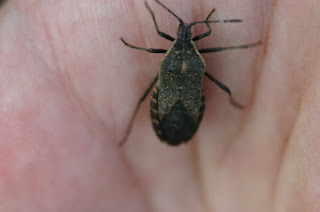
Thursday the class learned how a plant makes food for itself. That process is called photosynthesis. The chlorophyll in the choroplast grabs energyy from sunlight and combines it with the water and carbon dioxide the plant takes in to produce glucose and oxygen.
The cloroplast is what makes the leaves green. The students started an experiment where they covered part of a leaf on a few of their plants. In a couple of weeks they will uncover the leaf to see if it looks different than the other leaves.
No rain in the rain gauge since Monday. The young gardeners weeded, watered, and performed the never ending search for bad bugs. Garett has a small yellow squash on one of his plants.


It was so hot, the students were glad to go inside to the classroom. After the photosynthesis lesson, everyone stuffed and decorated a ladybug beanbag. These were tossed in the air to land on numbers to learn the hardiness zones. We'll hear more about those in a future lesson.
















